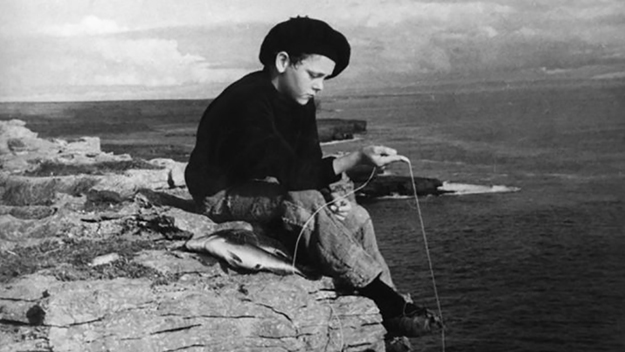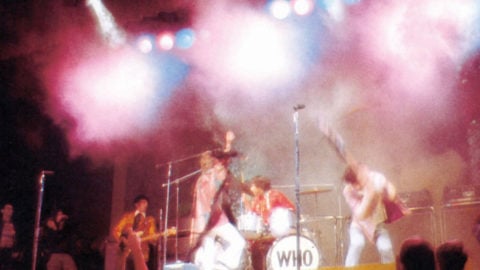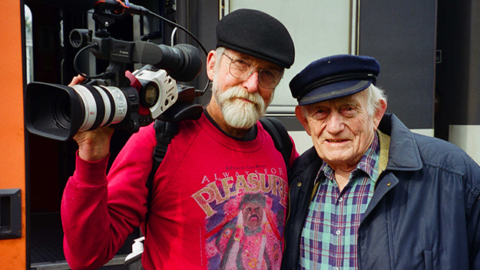TCM Diary: Man of Aran

In 1896, as the Irish Literary Revival blossomed, William Butler Yeats told young playwright John Millington Synge: “Give up Paris . . . Go to the Arran Islands. Live there as if you were one of the people themselves; express a life that has never found expression.” The Revival was an attempt to re-claim Irish culture and the Irish language, suppressed by centuries of British rule. Synge took Yeats’ advice, and moved to the Arans. The islands—Inishmore (the largest), Inishmaan and Inisheer (the smallest)—stretch across the mouth of Galway Bay, and the islanders still spoke Irish, still lived in the traditional ways. Synge’s classic 1907 book, The Aran Islands, is a poetic tribute to the islanders, showing how they represented a link with the lost Celtic past. Loaded down with symbolism, the islanders have been viewed with admiration or condescension, and reduced sometimes to stereotypes of the quaintly “primitive.” Robert Flaherty’s 1934 “documentary” Man of Aran (quotation marks necessary) is a huge part of this story.
In Man of Aran, the three main characters—The Man (Colman “Tiger” King), his wife (Maggie Dirrane), and their son (Michael Dillane)—live in almost constant battle with the elements. (They weren’t actually related: Flaherty cast his films.) The Man heads out to sea on fishing expeditions in the traditional Irish currach, the woman hauls seaweed on her back (used to sow potatoes in the scant soil), and the son perches on a cliff, tossing a baited line over the edge. The film culminates in a gigantic storm.
Man of Aran is dominated by the ocean. Waves fill the screen, edited in quick cuts, intensifying the sense of peril. Foam bubbles across the shore like spilled milk, in whorls and whirlpools of white against the black rocks. At times, it seems like the camera will be submerged. There are long shots of Inishmore’s Western coast, the cliffs battered by monster waves. I was on Inishmore years ago, deep into off-season, walking around on the cliffs, spray from hundreds of feet below exploding over me. Staggering back to the car, soaked, I thought of Synge’s description: “So much spray is in the air that a soft crust forms on the pages of the notebook where I write.” Flaherty captures this.
Flaherty was drawn to people seemingly untouched by progress. Realities that did not cooperate with his romantic views were left out. For example, the Inuit people in his 1922 surprise hit Nanook of the North were far more connected to the modern world of Canadian commerce than the film suggested. As Seán Crosson of the Huston School of Film and Digital Media remarks in A Boatload of Wild Irishmen, a documentary about Flaherty, “[Flaherty] had clearly been influenced by the Irish literary revival of the late 19th century. But it’s possible life on Aran was never like that. Perhaps it only existed in Flaherty’s mind.” Often filmed from a low angle, the characters tower into the sky, idealized peasants, like “workers” in a Soviet propaganda poster. When the Man swings a mallet over his head to crush rocks in the fields, his moves are punctuated with dramatic chords in the score by John Greenwood. He becomes an iconic representation of man in his natural state.
The most controversial sequence in Man of Aran, argued about to this day, is the shark hunt. As historians have pointed out, shark hunting hadn’t been done by the islanders for generations, since shark oil was transported to the islands from the mainland, and Flaherty had to bring people in to teach the Irishmen how to do it. The observer changes the observed, and this is very much the case in Flaherty’s work. In 1976, an Irish television crew tracked down Colman King, then living in England. When asked about Man of Aran, King said, “I knew very well it was bullshit.” The shark hunt is followed by a sequence where the men row home in the teeth of a storm, the currach buffeted by the waves. It was as dangerous as it looks. In a 1937 letter to producer Alexander Korda, while filming Elephant Boy in India, Flaherty defended himself from accusations of putting at risk the people in his films, adding, “I have already been accused of trying to drown a boatload of wild Irishmen on Aran!” Much later Flaherty said of the scene, “I should have been shot for what I asked these superb people to do for the film, for the enormous risks I exposed them to.” Maggie Dirrane almost drowned, and at one point the men have to drag her out of the water by her hair.
What Flaherty chose to exclude is eloquent of his purpose. The characters don’t gather together with others for music, dance and storytelling, essential parts of Irish rural life. There’s no religion in sight, even though the islands are hugely important in Irish Catholicism. (Saint Enda established a monastery on Inishmore in the late fifth century, generally thought to be the first of its kind.) Showing the family attending a dance or headed out to mass would ruin Flaherty’s vision of a pre-modern people. Man of Aran was shot as a silent, with dialogue dubbed in later, but Flaherty had his “actors” speak in English, not in Irish. The Irish language was suppressed, yet again. (In 1935 Flaherty directed a second Irish film, Oidhche Sheanchais, showing Seáinín Tom Ó Dioráin, a seanchaí—a storyteller and keeper of the Gaelic oral tradition—regaling a group of rapt listeners with a story. Everyone speaks in Irish in the film, making Oidhche Sheanchais the first Irish-language sync sound film. Thought lost for over 70 years, 15 minutes of a nitrate print was discovered in 2012 at Harvard, and can be seen on YouTube.)
Flaherty was not the first—nor the last—person to romanticize the Aran Islands. In James Joyce’s “The Dead,” when a woman chides Gabriel for vacationing in Europe instead of the Arans, Joyce (who left Ireland as soon as he could) lampoons the idea that the islands were somehow more authentic than other places. Recently, in his Aran Islands play trilogy, Martin McDonagh takes a different tougher tone (The Cripple of Inishmaan takes place during Flaherty’s time on the island, and depicts a disabled boy’s attempts to get a role in Man of Aran).
Flaherty’s reputation as the “father of documentary film” has been debated for 80 years, and his legacy is a mixed one, but in Man of Aran it’s Flaherty’s footage of the landscape that still shocks and stuns. The ferocity of the sea crashing against the sheer cliff faces, the towering geysers of foam, the pure wildness of it all—none of this is an exaggeration or a fiction.
Sheila O’Malley is a regular film critic for Rogerebert.com and other outlets including The Criterion Collection. Her blog is The Sheila Variations.






